Moldy sweetclover hay or spoiled silage contains a compound called dicoumarol. Dicoumarol is a blood-thinning agent that reduces the clotting ability of the blood, and livestock that ingest dicoumarol may die due to uncontrolled internal or external bleeding. Dicoumarol is formed from the organic compound, coumarin, by fungal metabolism in moldy sweetclover hay or spoiled sweetclover silage. Toxicity is only a concern when feeding hay, silage, or any stored form of sweetclover. Toxicity does not occur under grazing, even with high coumarin sweetclover cultivars.

Coumarin (see image on left) is a natural compound found in sweetclover. A single, partially-dominant gene controls the presence of coumarin and the potential for dicoumarol contamination but no low coumarin cultivars of annual sweetclover have ever been developed. ‘Denta’ is a low coumarin cultivar of biennial white sweetclover. Because of the biennial trait, Denta is poorly adapted to Texas but has been used as a parent in a breeding program to transfer the low coumarin gene into annual sweetclover cultivars for Texas.